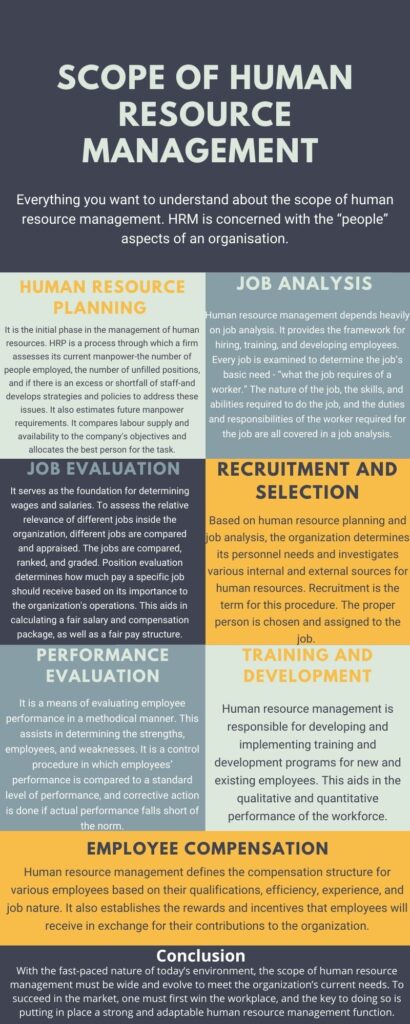In this blog, we will discuss everything you want to understand about the scope of human resource management. HRM is concerned with the “people” aspects of an organization.
Obtaining best human resource management software in Noida, developing their talents, motivating people for high performance, and ensuring that they maintain their commitment and loyalty to the high performance are the greatest ways to achieve organizational objectives.
HRM has a large range of applications. It encompasses all aspects of an employee’s working life.
Scope of HRM is comparatively broader with improved vision in terms of following sectors:
- (HRM) Human Resource Planning
- Job analysis
- Performance appraisal
- Recruitment and selection
- Training and development
- Employee motivation
- Employee compensation
- Industrial relation
- Employee welfare
- Career development
- Organizational development
- Performance management systems
- Employee assistance
- Job design
- Labor relations
- HR research and information systems and audit
- Quality of working life
- Personnel welfare.
Find out the scope of HRM (Human resource management).
Table of Contents
Human resource planning, job analysis, job evaluation, recruitment and selection, performance appraisal, and a few Human resource planning, job analysis, job assessment, recruiting and selection, performance review, and a few additional HRM responsibilities.
As a result, “management is a multifunctional profession with three duties, two of which are directly connected to personnel: managing a business, managing managers, and managing employees and the work,” as Peter Drucker accurately observed.
They help not only with the establishment of organizational rules but also with the understanding and execution of system rules. They are supposed to have the trust of both management and staff, which is required for the business organization to operate effectively and efficiently.
Human resource management is focused on personnel. It is a huge domain that involves several activities. A manager, whether in charge of production or marketing, works with people and gets his job done through and with them.
At last, HRM comprises of three aspects:
Personnel aspects
Manpower planning, recruitment, selection, placement, transfer, promotion, training and development, layoffs and retrenchments, remuneration, incentives, productivity, and so on are all covered.
Welfare aspects
It deals with issues such as canteens, creches, rest and lunchrooms, housing, transportation, medical aid, education, health and safety, and recreational facilities, among others.
Industrial Relations Aspects
This encompasses union-management relations, employee consultation, collective bargaining, grievance and disciplinary procedures, dispute resolution, and other things.
Human resource management’s (HRM) scope

Human Resource Planning
It is the initial phase in the management of human resources. HRP is a process through which a firm assesses its current manpower-the number of people employed, the number of unfilled positions, and if there is an excess or shortfall of staff-and develops strategies and policies to address these issues. It also estimates future manpower requirements. It compares labour supply and availability to the company’s objectives and allocates the best person for the task.
Job Analysis
Human resource management depends heavily on job analysis. It provides the framework for hiring, training, and developing employees. Every job is examined to determine the job’s basic need – “what the job requires of a worker.” The nature of the job, the skills, and abilities required to do the job, and the duties and responsibilities of the worker required for the job are all covered in a job analysis.
This helps in the recruiting and selection process, allowing for the appointment of the most qualified candidate for the job, as well as the organization of training and development programmes for employees to match their skills and abilities to the job requirements.
Job Evaluation
It serves as the foundation for determining wages and salaries. To assess the relative relevance of different jobs inside the organization, different jobs are compared and appraised. The jobs are compared, ranked, and graded. Position evaluation determines how much pay a specific job should receive based on its importance to the organization’s operations. This aids in calculating a fair salary and compensation package, as well as a fair pay structure.
Recruitment And Selection
Based on human resource planning and job analysis, the organization determines its personnel needs and investigates various internal and external sources for human resources. Recruitment is the term for this procedure. When it comes to find senior level candidates, they use executive search software. The proper person is chosen and assigned to the job.
Receiving applications, testing, interviews, medical examinations, and final selection are all part of the selection process. Employee happiness is improved through proper selection and placement, which helps the firm by increasing production and efficiency.
Performance Evaluation
It is a means of evaluating employee performance in a methodical manner. This assists in determining the strengths, employees, and weaknesses. It is a control procedure in which employees’ performance is compared to a standard level of performance, and corrective action is done if actual performance falls short of the norm.
This aids management in making decisions about promotions and salary raises which may be granted if an employee meets or exceeds the benchmark. It also assists management in determining the training and development requirements for employees who need to improve their skills.
Training And Development
Human resource management is responsible for developing and implementing training and development programs for new and existing employees. This aids in the qualitative and quantitative performance of the workforce.
Employees may benefit from training to adapt to changing technological and other internal and external work contexts. Employee development allows them to flourish in their current position while also preparing them for future posts with more responsibility.
Employee Compensation
Human resource management defines the compensation structure for various employees based on their qualifications, efficiency, experience, and job nature. It also establishes the and incentives and rewards program that employees will receive in exchange for their contributions to the organization. Corporate awards by Successories can be an integral part of this compensation structure.
Employee motivation
Employee motivation is critical for retaining and sustaining personnel inside the organization. When it comes to staff management, motivation is crucial. It assists in increasing employee productivity. Employees might be motivated in several different ways. Employees are motivated by recognition and reward for achievement, promotion, salary raises, and other monetary and nonmonetary incentives.
Employee welfare
Employee welfare is prioritized by human resource management, which includes canteens, creches, rest and lunchrooms, housing, transportation, medical aid, education, health and safety, medical care, sickness benefits, and recreation facilities.
It attempts to increase the quality of life at work by providing a better working environment, job security, flexible working hours, and eliminating workplace dangers, improving productivity and quality of work. Employees’ morale and motivation are enhanced by non monetary incentives in addition to monetary benefits.
Industrial Relation
Labor unrest, conflicts between workgroups, and conflicts between workers and management over low pay and a poor working environment are all common issues that must be carefully addressed by striking a balance between the workers’ interests and the organization’s and management’s interests. Human resource management aims to create and maintain a pleasant and cordial relationship between the employer and the employees.
Scope of Human resource management – as a profession
HRM has a wide range of applications. Any HR department and personnel executives often play a range of duties based on the situation. The HR manager fills a variety of functions, including those of researcher, counselor, mediator, peacemaker, problem-solver, etc.
Personnel management oversees all main activities in an employee’s working life, from when he joins the company until the time he leaves. Northcott lists the following functional categories of HRM: (a) employment, (b) selection and training, c) employee services, (d) wages, (e) industrial relations, (f) health and safety.
Many people consider HRM to be a career, even though it lacks all of the qualities of a profession. It is crucial to establish the key characteristics of work before determining whether it is a profession or not.
Specific Body Of Knowledge
Any profession should have a specific body of knowledge. HRM has evolved as its field of study. The complexity of operating businesses has resulted in new knowledge being added to the existing pool. As a result, HRM fulfills one of a profession’s most basic requirements.
Acquisition Of Knowledge
A person can only enter a profession after completing formal education and training. A professional’s academic knowledge combined with hands-on experience gained during their studies allows them to provide clients with efficient and effective service. As a result, the early acquisition of knowledge by formal methods receives a lot of attention.
HRM cannot be considered a profession under this condition because entry into the management discipline is not limited to management graduates. A person pursuing any field is entitled to pursue a management discipline or any of its particular branches.
Professional Association
An association should exist for each occupation that claims to be professional. To control and grow professional activity, a representative body of professionals is required. The governing body should establish the requirements for becoming a member of the organization. Although there are a few HR associations in India, such as the national institute of personnel management and other HR professional associations, no single organization unites all HR professionals under one umbrella. As a result, HRM cannot be considered a pure profession.
Ethical Code
Every profession has its set of ethical guidelines. All members must follow these requirements. The ethical code limits the amount of authority that people can have. Because a member’s power may be misused due to his skill in a particular field, a code of ethics must regulate their influence. Aside from that, the code of conduct allows a client to determine the quality of service offered by specialists.
However, HRM, there is no globally accepted ethical code for HR practitioners worldwide. On the other hand, managers are required to be socially responsible and safeguard stakeholders’ interests like consumers, suppliers, financiers, creditors, the government, and the general public. The application of an ethical code by HR professionals is worthless without a single representative association.
Service Motive
According to the service motive, professionals should keep social interest in mind while charging prices for their professional services. In the lack of a market device, such as competition among professionals, the monetary worth of services performed cannot be accurately measured.
Professionals can charge more excellent prices because of their specialist knowledge, but their service is genuinely judged in terms of the social benefit they provide, not in terms of money. This is also true in HRM. Management is a uniting force, and its contribution to society through integrating heterogeneous resources into productive units is more important for society’s stability.
Conclusion (scope of human resource management)
in this blog, you have learned about the scope of human resource management. I hope you have understood. With the fast-paced nature of today’s environment, the scope of human resource management must be wide and evolve to meet the organization’s current needs. To succeed in the market, one must first win the workplace, and the key to doing so is putting in place a strong and adaptable human resource management function. And also if you need human resource management assignment help then you are in the right place. Our expert will provide you the best services.
FAQs related to scope of human resource management
Why is HR so important?
HR has a critical role in shaping, strengthening, and changing an organization’s culture. HR is responsible for several aspects of business culture, including pay, performance management, training and development, recruitment and onboarding, and reinforcing the company’s values.
What is HR’s main focus?
A human resource manager’s duties are divided into three categories: staffing, employee compensation and benefits, and defining/designing work. HRM’s primary goal is to increase an organization’s productivity by maximizing the efficacy of its personnel.



